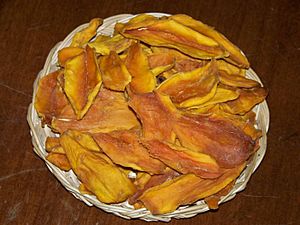Dried mango facts for kids
Dried mango is a yummy snack made from the sweet mango fruit. To make it, the fresh mango is sliced and then dried. This process takes out most of the water, making the mango chewy and easy to store for a long time.
Contents
How Dried Mango is Made
Making dried mango involves taking out the water from the fruit. This is usually done using warm air.
The Drying Process
First, fresh mangoes are sliced. These slices still have moisture on their surface. A common way to dry them is using a machine that blows warm, dry air. This warm air flows around the mango slices, heating them up. The heat helps the water on the surface of the mango to turn into vapor and float away.
As the surface water evaporates, more water from deep inside the mango moves to the surface. This movement of water from the inside to the outside is called diffusion. The warm air then carries away this new moisture too. Slowly, the mango slices lose more and more water. They will start to shrink as their cells lose water.
Avoiding Case-Hardening
It's important not to dry the mango too quickly or with air that is too hot. If the outside of the mango dries much faster than the inside, it can form a hard, tough layer on the surface. This is called case-hardening.
When case-hardening happens, the hard outer layer traps the moisture inside the mango. This makes it very difficult for the rest of the water to escape. If the inside stays wet, the dried mango might spoil faster when stored. So, drying needs to be done carefully to make sure the mango dries evenly all the way through.
What's Inside Dried Mango?
Dried mango is a good source of energy and has important nutrients, though some change during drying.
Nutrients and Vitamins
Fresh mangoes are full of Vitamin C. When mangoes are dried, some of their Vitamin C is lost. However, dried mango still has a lot of fiber, which is good for your digestion. It also contains antioxidants, which are substances that help protect your body's cells.
A 100-gram serving of dried mango has about 314 calories. Most of these calories come from carbohydrates, which give you energy. Dried mango also provides a good amount of Vitamin A, and some Vitamin B, D, and E. While most Vitamin C is lost, it still has small amounts of minerals like calcium, iron, and phosphorus.
If mangoes are blanched (quickly dipped in hot water) before drying, they can keep more of their Vitamin C and other helpful compounds called carotenoids.
Antioxidants in Mango
Like many fruits, mangoes have natural antioxidants, such as one called mangiferin. These antioxidants are like tiny shields for your body's cells. They can help protect cells from damage that might be linked to health issues like diabetes or even just getting older.
Storing Dried Mango
Dried mango can last much longer than fresh mango if stored correctly.
How to Keep it Fresh
Fresh mango usually lasts only about five days. But dried mango can last for many months, or even years! How long it lasts depends on how it was dried and how you store it.
To keep dried mango fresh, store it in containers that seal tightly. This keeps out air, moisture, and anything else that could spoil it. You can keep unopened dried mango in your pantry (a cool, dark place) for about 6 to 12 months.
If you store it in the refrigerator, it can last even longer, usually 1 to 2 years. For the longest storage, you can put it in the freezer. When frozen at 0°F (about -18°C), dried mango can last for a very long time, sometimes even indefinitely for best quality.
When Dried Mango Goes Bad
Even though dried mango lasts a long time, it can still go bad. It's a good idea to check it before you eat it. Look for any changes in color, like dark spots. Also, smell it – if it has a strange or bad odor, it's best to throw it away. If you see any mold, you should definitely discard it. Over time, dried mango might also become very hard or lose its flavor.


